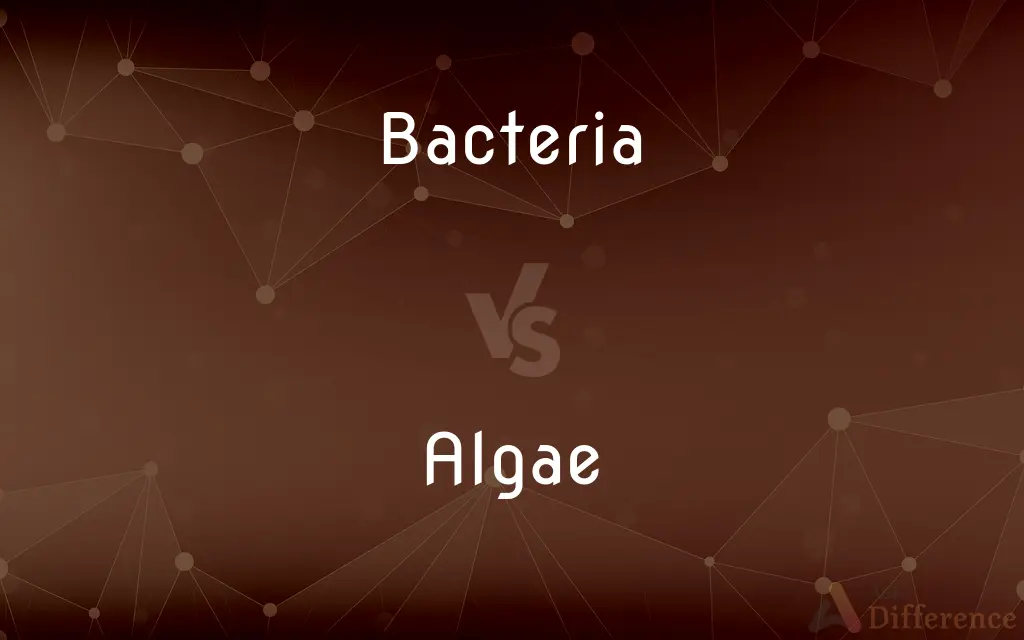Bacteria vs. Algae — What's the Difference?
By Maham Liaqat & Fiza Rafique — Updated on March 21, 2024
Bacteria are single-celled microorganisms with a simple internal structure, while algae are primarily aquatic, photosynthetic organisms that can be single-celled or multicellular.

Difference Between Bacteria and Algae
Table of Contents
ADVERTISEMENT
Key Differences
Bacteria are microscopic, single-celled organisms known for their simple structure without a true nucleus, thriving in diverse environments including soil, water, and living in or on other organisms. Algae, on the other hand, are primarily aquatic and photosynthetic organisms, ranging from single-celled microalgae to large multicellular forms like seaweeds, and possess chlorophyll for photosynthesis but are not true plants.
Bacteria play crucial roles in various biological processes, including fermentation, nitrogen fixation, and as pathogens causing diseases. Algae are vital to ecosystems as primary producers, converting sunlight into energy through photosynthesis and significantly contributing to oxygen production in aquatic environments.
The reproduction in bacteria primarily occurs asexually through binary fission, resulting in rapid population growth under favorable conditions. Whereas algae can reproduce through a variety of methods including asexual reproduction, sexual reproduction, and fragmentation, depending on the species.
Bacteria can be found in almost every conceivable environment on Earth, including extreme conditions where other life forms cannot survive, such as hot springs and radioactive waste. Algae, while predominantly aquatic, also inhabit a variety of environments but usually require a moist or aquatic habitat to grow.
While bacteria are often associated with disease and decay, many species are beneficial and essential for processes such as decomposing organic matter and the production of antibiotics, vitamins, and biotechnology products. Algae, besides their ecological roles, are utilized in industries such as food, fodder, fertilizers, and biofuels, highlighting their economic importance.
ADVERTISEMENT
Comparison Chart
Cellular Structure
Single-celled, lacking a true nucleus (prokaryotic)
Single-celled or multicellular, with a true nucleus (eukaryotic)
Habitat
Varied (soil, water, air, living organisms), including extremes
Primarily aquatic, some in moist terrestrial environments
Photosynthesis
Some bacteria can photosynthesize, but not all
Predominantly photosynthetic, containing chlorophyll
Reproduction
Primarily asexual through binary fission
Asexual and sexual methods, varies by species
Role in Nature
Decomposers, nitrogen fixers, pathogens
Primary producers, oxygen production through photosynthesis
Compare with Definitions
Bacteria
Some species can photosynthesize or fix nitrogen.
Cyanobacteria are photosynthetic bacteria important for nitrogen cycling.
Algae
Can reproduce asexually or sexually, depending on the species.
Volvox algae can form daughter colonies through asexual reproduction.
Bacteria
Found in virtually every environment on Earth.
Thermus aquaticus thrives in hot springs.
Algae
Primary producers in aquatic environments.
Algae are crucial for oxygen production in oceans.
Bacteria
Single-celled microorganisms without a true nucleus (prokaryotic).
Escherichia coli is a type of bacteria found in the human gut.
Algae
Used in food, biofuel production, and as bioindicators for water quality.
Algae are harvested for making agar and carrageenan.
Bacteria
Can be beneficial or pathogenic to humans, animals, and plants.
Lactobacillus bacteria are used in yogurt production.
Algae
Photosynthetic organisms, single-celled or multicellular, not classified as true plants.
Chlorella is a single-celled algae used as a dietary supplement.
Bacteria
Reproduce asexually through binary fission.
Bacteria in petri dishes can double in number rapidly.
Algae
Thrive in moist or aquatic habitats.
Green algae can commonly be found in freshwater ponds.
Bacteria
Bacteria ( (listen); common noun bacteria, singular bacterium) are a type of biological cell. They constitute a large domain of prokaryotic microorganisms.
Algae
Algae (; singular alga ) is an informal term for a large and diverse group of photosynthetic eukaryotic organisms. It is a polyphyletic grouping that includes species from multiple distinct clades.
Bacteria
Plural of bacterium.
Algae
Any of numerous photosynthetic organisms of aquatic or moist habitats, ranging in size from single-celled diatoms to large seaweeds such as kelp, and characterized by a lack of complex organs and tissues. Once classified within the plant kingdom, the algae are now considered to include several unrelated groups belonging to different kingdoms.
Bacteria
(US) A type, species, or strain of bacterium.
Algae
Algal organisms viewed collectively or as a mass; algal growth.
Bacteria
Alternative form of bacterium.
Algae
(countable) A particular kind of algae.
Bacteria
Lowlife, slob (could be treated as plural or singular).
Algae
Plural of alga.
Bacteria
An oval bacterium, as distinguished from a spherical coccus or rod-shaped bacillus.
Algae
Primitive chlorophyll-containing mainly aquatic eukaryotic organisms lacking true stems and roots and leaves
Bacteria
See Bacterium.
Bacteria
(microbiology) single-celled or noncellular spherical or spiral or rod-shaped organisms lacking chlorophyll that reproduce by fission; important as pathogens and for biochemical properties; taxonomy is difficult; often considered plants
Common Curiosities
What are bacteria?
Bacteria are single-celled, microscopic organisms with a simple internal structure that lack a true nucleus.
How do bacteria reproduce?
Bacteria reproduce asexually through a process called binary fission.
Are all algae aquatic?
While most algae are aquatic, some species live in moist terrestrial environments.
Can bacteria photosynthesize?
Some bacteria can photosynthesize, but not all. Examples include cyanobacteria.
What is the significance of algae in ecosystems?
Algae serve as primary producers, converting sunlight into energy that supports food webs, and they play a key role in oxygen production in aquatic environments.
In what environments can bacteria and algae be found?
Bacteria can inhabit virtually any environment, including extreme conditions. Algae primarily require aquatic or moist environments.
What are algae?
Algae are primarily aquatic, photosynthetic organisms that can be single-celled or multicellular, and are not true plants.
How do algae reproduce?
Algae can reproduce through asexual reproduction, sexual reproduction, or fragmentation, depending on the species.
Are bacteria harmful to humans?
While some bacteria cause diseases, many are beneficial and essential for processes like digestion and the production of vitamins.
How do bacteria and algae contribute to the environment?
Bacteria are key decomposers and nutrient cyclers, while algae are major oxygen producers and primary producers in aquatic ecosystems.
What is the ecological role of bacteria?
Bacteria are crucial for processes such as nitrogen fixation, decomposition, and serving as a foundation for many food webs.
Can algae be used in industry?
Yes, algae are used in various industries, including food, biofuel production, and the manufacturing of biodegradable plastics.
What differentiates bacteria from algae in terms of cellular structure?
Bacteria are prokaryotic, lacking a true nucleus, whereas algae are eukaryotic, with a true nucleus and organelles.
Why are algae not considered true plants?
Although algae perform photosynthesis like plants, they lack the distinct organs (such as leaves and roots) found in true plants and have different life cycles and cellular structures.
Can both bacteria and algae be multicellular?
Bacteria are typically single-celled, although some form colonies that may appear multicellular. Algae can be truly multicellular, forming complex structures like seaweeds.
Share Your Discovery

Previous Comparison
Washroom vs. Restroom
Next Comparison
Bakery vs. ConfectioneryAuthor Spotlight
Written by
Maham LiaqatCo-written by
Fiza RafiqueFiza Rafique is a skilled content writer at AskDifference.com, where she meticulously refines and enhances written pieces. Drawing from her vast editorial expertise, Fiza ensures clarity, accuracy, and precision in every article. Passionate about language, she continually seeks to elevate the quality of content for readers worldwide.
















































